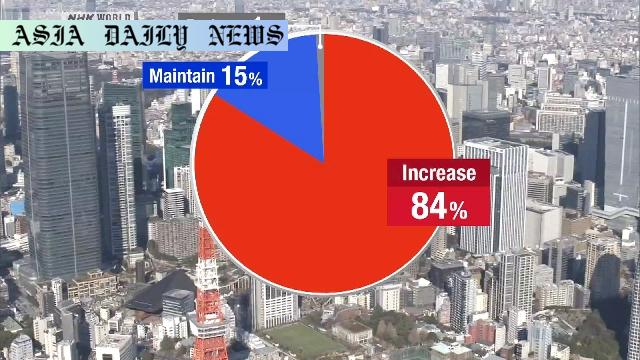Price Hikes: Over 80 percent of major Japanese firms anticipate increasing prices in 2025 due to rising raw material, energy, and labor costs.

Japanese Firms Grapple with Expected Price Hikes in 2025
A recent survey conducted by NHK reveals a significant shift in the pricing strategies of major companies in Japan. Over 80% of respondents indicated that they anticipate raising prices on their products and services by 2025. This trend reflects the broader economic challenges faced by businesses, including increasing costs of raw materials, energy, and wages.
Survey Insights and Methodology
The survey was conducted between mid-December and mid-January, involving 100 major firms in Japan, with responses from 68 of them. Eighty-four percent of these companies confirmed plans to generally increase their prices in 2025, while 15% stated they will largely maintain current price levels, and only 1% projected a reduction in prices. The survey allowed multiple responses to explain the reasoning behind the expected price hikes.
Drivers of Price Increases
Among the companies forecasting price hikes, the most cited reason was the growing prices of raw materials and energy, reflecting ongoing inflationary pressures in global markets. Additionally, firms noted the necessity of funding wage hikes and other rising personnel costs in light of Japan’s labor market conditions. Many respondents also mentioned that sustained price increases were a strategy to improve profitability and ensure business stability over the long term.
Firms Opting for Stability
On the other hand, some companies plan to keep or lower their current price levels despite the rising operational costs. These firms highlighted potential customer loss as a reason to avoid price hikes. They also emphasized strategies to enhance price competitiveness, including initiatives like overhauling their production systems to better absorb costs, thus maintaining competitive pricing without compromising on quality or customer retention.
Economic Implications of Price Adjustments
The survey results underscore a key intersection of business profitability and consumer behavior. On one hand, price hikes can help firms manage rising costs, but on the other, they could drive customers to seek alternative options, especially if price sensitivity prevails. This dual challenge is especially pronounced in an economy like Japan’s, where deflationary pressures have often encouraged firms to maintain or lower prices.
Looking Ahead
As firms prepare for the anticipated price increases in 2025, they face critical decisions in balancing profitability and customer satisfaction. Over the next two years, elements such as global supply chains, energy costs, and labor market dynamics will play pivotal roles in shaping these pricing strategies. Furthermore, government and industry incentives to improve efficiency and resource utilization could be essential in mitigating some of the financial burdens faced by businesses.
Conclusion
The NHK survey provides a glimpse into the thoughts and strategies of Japanese corporations as they navigate a complex economic landscape. The findings highlight the challenges of rising costs and its impact on pricing policies, while also showcasing innovative approaches to minimize the burden on both companies and consumers. The overarching narrative moving into 2025 is one of resilience and adaptability.
Commentary
Rising Costs and Price Adjustments
The prospect of rising prices can be daunting for both businesses and consumers. On the one hand, companies are grappling with increasing costs of raw materials, energy, and wages, which places strain on profitability. On the other hand, consumers, already facing tightening budgets, may respond negatively to price hikes, affecting their purchasing decisions.
Challenges Businesses Face
For Japanese firms, the decision to raise prices is not taken lightly. Many fear the potential loss of loyal customers or risk diminishing their market share. Yet, with inflationary pressures and a push toward higher wages for employees, there are limited alternatives for many companies. This conundrum highlights the broader challenges in managing cost increases while also ensuring competitiveness and consumer satisfaction.
Opportunities for Innovation
Despite these challenges, price increases present opportunities for innovation. Companies could invest in technology to overhaul production systems or adopt more efficient practices that offset growing costs. These measures not only improve the bottom line but also enable firms to maintain or improve service quality without passing excessive burdens to consumers.
Final Thoughts
The shifting dynamics of Japan’s corporate strategies reflect a broader global issue—balancing cost management with customer retention. Firms that pivot toward efficiency, transparency, and innovation may find themselves in a stronger position to weather these challenges. Moving into 2025, it will be interesting to observe how Japanese companies tackle these hurdles while fostering long-term growth and stability.


